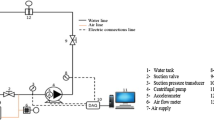Abstract
Cavitation is an important problem that occurs in any pump and contributes highly towards the deterioration in the performance of the pump. In industrial applications, it is vital to detect and decrease the effect of cavitation in pumps. In this study therefore, focus is on detecting and diagnosing the cavitation phenomenon within a centrifugal pump using vibration technique. The results obtained for vibration signal in time and frequency domains have been analysed in order to achieve a better understanding regarding detection of cavitation within a pump. The effect of different operating conditions, including various flow rates related to the cavitation have been investigated in this work using different statistical features in time domain analysis (TDA). Moreover, Fast Fourier Transform (FFT) technique for frequency domain analysis (FDA) has also been applied.













Similar content being viewed by others
References
Al-Obaidi A (2018) Experimental and numerical investigations on the cavitation phenomenon in a centrifugal pump (Doctoral dissertation, University of Huddersfield)
Zhang N, Yang M, Gao B, Li Z (2015) Investigation on vibration characteristics in a centrifugal pump with special slope volute. Advances in Mechanical Engineering 7(2):936218
Stopa MM, Cardoso Filho BJ, Martinez CB (2012) Detection of incipient cavitation phenomenon in a centrifugal pump. In: 2012 IEEE Industry Applications Society Annual Meeting
Chudina M (2003) Noise as an Indicator of cavitation in a centrifugal pump. Acoust Phys 49(4):463–474
Černetič J, Prezelj J, Čudina M (2008) Use of noise and vibration signal for detection and monitoring of cavitation in kinetic pumps. The Journal of the Acoustical Society of America 123(5):3316–3316
Albraik A, et al (2012) Diagnosis of centrifugal pump faults using vibration methods. In Journal of Physics: Conference Series. IOP Publishing
Suhane A (2012) Experimental study on centrifugal pump to determine the effect of radial clearance on pressure pulsations, vibrations and noise. Int J Eng Res Appl 2(4):1823–1829
Farokhzad S, Bakhtyari N, Ahmadi H (2013) Vibration Signals Analysis and Condition Monitoring of Centrifugal Pump. Tech J Eng Appl Sci 4:1081–1085
Kamiel BP (2015) Vibration-based multi-fault diagnosis for centrifugal pumps. (Doctoral dissertation, Curtin University)
Al-Obaidi AR (2019) Effects of different turbulence models on three-dimensional unsteady cavitating flows in the centrifugal pump and performance prediction. International Journal of Nonlinear Sciences and Numerical Simulation 20(3–4):487–509
Peters J (2015) Beginning Vibration Analysis with Basic Fundamentals. USA Vibration Analysis Hardware
Al-Obaidi AR (2019) Experimental investigation of the effect of suction valve opening on the performance and detection of cavitation in the centrifugal pump based on acoustic Analysis technique. Archives of Acoustics 44(1):59–69
Karassik IJ (1998) Centrifugal pumps. second edition ed
Al-Obaidi AR (2019) Investigation of effect of pump rotational speed on performance and detection of cavitation within a centrifugal pump using vibration analysis. Heliyon 5(6):e01910
Al-Obaidi, A. R. (2019). Numerical investigation of flow field behaviour and pressure fluctuations within an axial flow pump under transient flow pattern based on CFD Analysis method. In Journal of Physics: Conference Series (Vol. 1279, no. 1, p. 012069). IOP publishing
Hernandez-Solis A (2006) Diagnosis of Centrifugal Pumps. Skolan för elektro-och systemteknik, Kungliga Tekniska högskolan
Al-Obaidi AR (2019) Investigation of fluid field analysis, characteristics of pressure drop and improvement of heat transfer in three-dimensional circular corrugated pipes. Journal of Energy Storage 26:101012
Alfayez L, Mba D, Dyson G (2005) The application of acoustic emission for detecting incipient cavitation and the best efficiency point of a 60kW centrifugal pump: case study. NDT and E International Independent Nondestructive Testing and Evaluation 38(5):354–358
Al-Obaidi AR, Towsyfyan H (2019) An experimental study on vibration signatures for detecting incipient cavitation in centrifugal pumps based on envelope Spectrum Analysis. Journal of Applied Fluid Mechanics 12(6):2057–2067
Tuzson J (2000) Centrifugal pump design. John Wiley & Sons
Goyal D, Pabla B (2016) The vibration monitoring methods and signal processing techniques for structural health monitoring: a review. Archives of Computational Methods in Engineering 23(4):585–594
Al-Obaidi AR (2019) Monitoring the performance of centrifugal pump under single-phase and cavitation condition: a CFD analysis of the number of impeller blades. J Appl Fluid Mech 12(2):445–459
Acknowledgments
The author would like to thank Mustansiriyah University (www.uomustansiriyah.edu.iq) Baghdad – Iraq for its support in the present work. The author also would like to gratefully acknowledge the University of Huddersfield (UK) due to the model geometry and numerical data were carried out when the author was studied his PhD degree in this University.
Author information
Authors and Affiliations
Corresponding author
Additional information
Publisher’s Note
Springer Nature remains neutral with regard to jurisdictional claims in published maps and institutional affiliations.
Rights and permissions
About this article
Cite this article
Al-Obaidi, A. Detection of Cavitation Phenomenon within a Centrifugal Pump Based on Vibration Analysis Technique in both Time and Frequency Domains. Exp Tech 44, 329–347 (2020). https://doi.org/10.1007/s40799-020-00362-z
Received:
Accepted:
Published:
Issue Date:
DOI: https://doi.org/10.1007/s40799-020-00362-z




